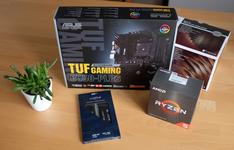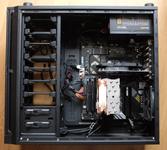Upgrading my desktop PC
Vincent Bernat
I built my current desktop PC in 2014. A second SSD was added in 2015. The motherboard and the power supply were replaced after a fault1 in 2016. The memory was upgraded in 2018. A discrete AMD GPU was installed in 2019 to drive two 4K screens. An NVMe disk was added earlier this year to further increase storage performance. This is a testament to the durability of a desktop PC compared to a laptop: it’s evolutive and you can keep it a long time.
While fine for most usage, the CPU started to become a bottleneck during video conferences.2 So, it was set for an upgrade. The table below summarizes the change. This update cost me about €800.
| Before | After | |
|---|---|---|
| CPU | Intel i5-4670K @ 3.4 GHz | AMD Ryzen 5 5600X @ 3.7 GHz |
| CPU fan | Zalman CNPS9900 | Noctua NH-U12S |
| Motherboard | Asus Z97-PRO Gamer | Asus TUF Gaming B550-PLUS |
| RAM | 2×8 GB + 2×4 GB DDR3 @ 1.6 GHz | 2×16 GB DDR4 @ 3.6 GHz |
| GPU | Asus Radeon PH RX 550 4G M7 | ← |
| Disks | 500 GB Crucial P2 NVMe 256 GB Samsung SSD 850 256 GB Samsung SSD 840 |
← |
| PSU | be quiet! Pure Power CM L8 @ 530 W | ← |
| Case | Antec P100 | ← |
According to some benchmark, the new CPU should be 4× faster when all cores are used and 1.5× faster for a single-threaded workload. Compiling an arbitrary3 kernel provides a 3× speedup. Before:
$ lscpu -e CPU NODE SOCKET CORE L1d:L1i:L2:L3 ONLINE MAXMHZ MINMHZ 0 0 0 0 0:0:0:0 yes 3800.0000 800.0000 1 0 0 1 1:1:1:0 yes 3800.0000 800.0000 2 0 0 2 2:2:2:0 yes 3800.0000 800.0000 3 0 0 3 3:3:3:0 yes 3800.0000 800.0000 $ CCACHE_DISABLE=1 =time -f '⌛ %E' make -j$(nproc) […] OBJCOPY arch/x86/boot/vmlinux.bin AS arch/x86/boot/header.o LD arch/x86/boot/setup.elf OBJCOPY arch/x86/boot/setup.bin BUILD arch/x86/boot/bzImage Kernel: arch/x86/boot/bzImage is ready (#1) ⌛ 4:54.32
After:
$ lscpu -e CPU NODE SOCKET CORE L1d:L1i:L2:L3 ONLINE MAXMHZ MINMHZ 0 0 0 0 0:0:0:0 yes 5210.3511 2200.0000 1 0 0 1 1:1:1:0 yes 4650.2920 2200.0000 2 0 0 2 2:2:2:0 yes 5210.3511 2200.0000 3 0 0 3 3:3:3:0 yes 5073.0459 2200.0000 4 0 0 4 4:4:4:0 yes 4932.1279 2200.0000 5 0 0 5 5:5:5:0 yes 4791.2100 2200.0000 6 0 0 0 0:0:0:0 yes 5210.3511 2200.0000 7 0 0 1 1:1:1:0 yes 4650.2920 2200.0000 8 0 0 2 2:2:2:0 yes 5210.3511 2200.0000 9 0 0 3 3:3:3:0 yes 5073.0459 2200.0000 10 0 0 4 4:4:4:0 yes 4932.1279 2200.0000 11 0 0 5 5:5:5:0 yes 4791.2100 2200.0000 $ CCACHE_DISABLE=1 =time -f '⌛ %E' make -j$(nproc) […] OBJCOPY arch/x86/boot/vmlinux.bin AS arch/x86/boot/header.o LD arch/x86/boot/setup.elf OBJCOPY arch/x86/boot/setup.bin BUILD arch/x86/boot/bzImage Kernel: arch/x86/boot/bzImage is ready (#1) ⌛ 1:40.18
Here we go for another seven years!
-
The original power supply was from an older configuration. It suddenly became unable to reliably start the PC. The motherboard got replaced as it was the first suspect: without load, the power supply was working correctly. ↩︎
-
On Linux, many programs are unable to leverage hardware acceleration. This is a pity. On a laptop, this can also draws the battery pretty fast. ↩︎
-
The kernel is configured with
make defconfigon commit 15fae3410f1d. ↩︎


